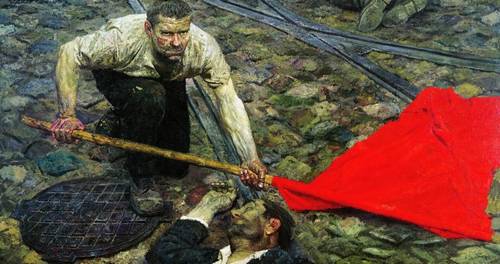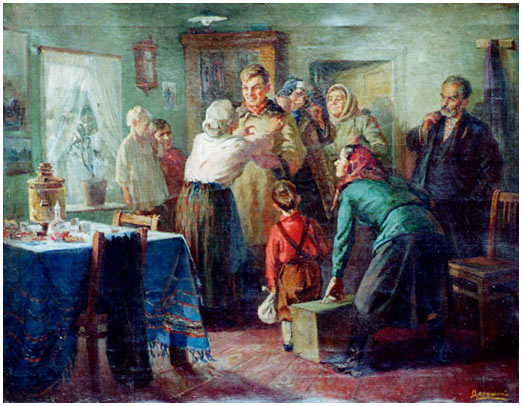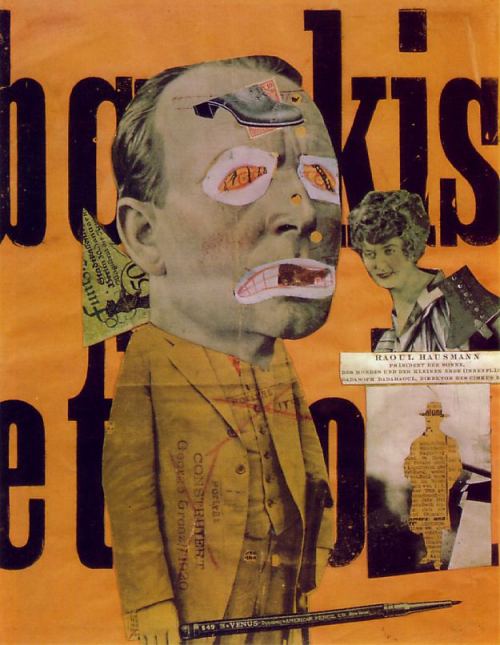The DU Lounge
Related: Culture Forums, Support ForumsThe Origins of Socialist Realism.
Last edited Sat Apr 16, 2022, 08:32 AM - Edit history (1)

1982, Vitaly Komar (American, b. 1943 Moscow, Russia) and Alexander Melamid, (American, b.1945, Moscow, Russia)
At the Zimmerli Art Museum, Rutgers University, New Brunswick, NJ
CaliforniaPeggy
(149,611 posts)I must confess that this is out of my ken.
Socialist Realism?
I need educating!
It looks very interesting, but frankly, I don't get it.
Still, I thank you for posting it. I like getting my horizons broadened.
![]()
rug
(82,333 posts)
The antithesis to Norman Rockwell.

CaliforniaPeggy
(149,611 posts)Those paintings by Norman Rockwell are diametrically opposed to the one featured.
rug
(82,333 posts)
Happy Reuniting. Post-Stalin (1950s). Painted by Deryazhny Fedor Ivanovich (Ukraine). Oil on Canvas, 66 x 86cm.

Thanksgiving
JVS
(61,935 posts)Rockwell seems similar to socialist realism. He depicts things realistically instead of symbolically, abstractly, or with distorted or grotesque forms. He is civic minded like the social realists.
rug
(82,333 posts)They're both appealing to the masses. Realism's a far better medium than this:

Raoul Hausmann, 1919 The Art Critic
NNadir
(33,516 posts)Last edited Sat Apr 26, 2014, 06:47 PM - Edit history (1)
In real life, it's quite large, beautifully executed, stunningly so, and very, very, very funny, if anything about Josef Stalin can be truly funny.
I was at the Zimmerli today with my family, and the minute I came upon this painting I ran to get my son, who is an artist himself.
Stalin was, of course, one of the most brutal dictators of the 20th century, if not the most brutal dictator.
In what Khrushchev described as "the cult of personality," Stalin was often represented as the world's greatest genius, and one represented him otherwise under pain of death. Not only was he a "genius" but he was a genius about all things: science, economics, agriculture, military affairs and, of course, like others of his ilk and time, art.
Stalin decreed that all art had to be dedicated to showing the glory and power of the Soviet state, and one dared not do otherwise. Thus Soviet artists often ended up making paintings of tractors, weapons systems, Soviet monuments to the "Great Patriotic War," happy socialist workers working in factories in the grand Soviet nirvana, etc...etc...
This was called "Socialist Realism." Under the dictatorship of "Socialist Realism," Soviet artists were generally excluded from the wonderful art movements taking place all around the world, a tragedy when you consider the talent of Russian, and non-Russian Soviet artists, of which the Zimmerli has a wonderful sample.
Kumar and Miland, who worked together, were trained into this "Socialist Realism" tradition, having lived under Khrushchev's artistic thaw only briefly as young men, but they were aware of the greater art world beyond Soviet borders.
The painting, which was executed by the artists after they had escaped the Soviet Union - some of their works had been destroyed at a clandestine open air art show by Bulldozers in the 1960's and they had both been arrested under Brezhnev - makes wry reference to a Greek myth in which art was created by one of the muses by tracing the shadow of her beloved. The muse of course is well, a goddess, but it is hilarious to think of Stalin as "beloved." Stalin's body is bloated, as if he were suffering from edema, and his crippled arm is hidden behind the beautiful muse as she traces his shadow, his weak chin decidedly not god like, as he glares with his frightening steely sadistic gaze at its worst.
It's a remarkable painting I think.
The Zimmerli has a wonderful gallery of Soviet "subversive" art. There is a very remarkable painting by the Estonian artist Rein Tammik called "In the Studio." My family spent a long time discussing that painting today. Maybe I'll put it up here in the future.
CaliforniaPeggy
(149,611 posts)The painting seems more grotesque than funny, but that's probably because I haven't seen it in person. Your explanation is fascinating.
I think posting "In the Studio" would be a great idea. I am sadly deficient in my history of Soviet art, subversive or otherwise.
NNadir
(33,516 posts)It's hard to think of Stalin, really, given his crimes against humanity, in any other way, other than to use the word, "grotesque," so you're definitely on to something.
Nevertheless there is a sardonic element to the painting, and my son and I couldn't help but laugh at the way they surrounded that, well, "grotesque" element of their painting, which of course is Stalin himself, with such a beautifully executed neoclassical element. Sometimes I think there is nothing one can do about a tragedy of that magnitude but to shake one's head and laugh. Or maybe our sense of humor borders on perverse.
Komar and Meland were apparently arrested for a sculpture they produced featuring both Lenin and Stalin while they still lived in the Soviet Union, apparently because the Soviet authorities of the time claimed the sculptures involved "ridicule." I have no idea whether the sculptures were destroyed. Probably. One of their works in the West had apparently been slashed - I forget which work and where it took place - by a Trotskyite. They refused to have the work repaired, calling the slasher a "collaborator" in the work.
Both artists, apparently, live in New Jersey now, although they no longer collaborate on works, but work independently. This work was the only one that was at the Zimmerli, but apparently they have works at the Modern in New York and other great museums. The next time I'm at the Modern, I'll look out for their stuff if it's on display.
They are very interesting artists in any case, and Russia's loss is America's gain.
I will post "In the Studio" in the future. I have to run to the library to do some research today, but I'll try to get it up soon.
Kali
(55,007 posts)I am at this moment visiting my father's widow, a Russian who lived through those times. I need to learn/hear more of her history.
NNadir
(33,516 posts)...from the Ukrainian famine of the 1920's and 1930's. There was plenty of wheat grown, but Stalin was selling it all to buy machine tools from the West, mostly Germany.
I was a child and all I knew of my neighbor's parents - who eventually moved in with their daughter - was that they'd left "Russia" before World War II.
They used to give me Soviet stamps for my stamp collection from their letters from relatives left behind.
I wish I'd known then what I know now, since they could have provided an interesting oral history. The mother lived to be over 100, and I knew her into my early 20's.
People who lived under Stalin are dying off now, and what they suffered needs to be remembered somehow.
Thanks for your comment.
RedCloud
(9,230 posts)People of Polish origin seemed to hate me a lot.
I bore a lot in common with this mugshot #9...
http://www.cracked.com/blog/14-photographs-that-shatter-your-image-famous-people/
Maybe a little more beard and greener eyes.
We have since gone very separate ways.
NNadir
(33,516 posts)...allegedly he had a beautiful singing voice as well, and was pretty good at telling a joke.
The penalty for not laughing at the last part, of course, was death, so we don't really have any feedback from people who didn't think he was funny. They didn't live long.
That's probably also true of people who think he didn't sing well.
If it's any consolation, my father in his later years developed a striking similarity in looks to Adolf Eichmann, at least in comparison to the photos taken of Eichmann before he was executed.
Worse, he was partially of Austrian descent, although his Grandfather left Austria in the mid 19th century.